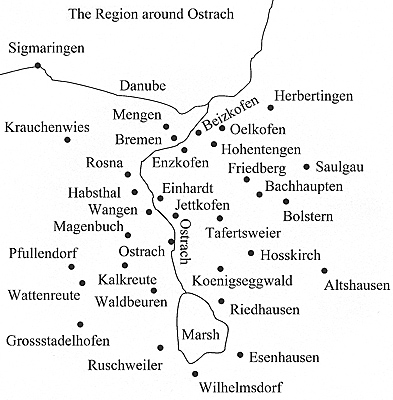Battle of Ostrach
21 March 1799
Introduction
by Roland Kessinger, Germany
| |
In France itself the government, the so-called Directory, was not able to
stabilise the internal political situation. Since the outbreak of the French
Revolution in 1789 the French state was bankrupt and France bitterly
needed the money from the newly occupied European countries such as
Belgium (still called the Austrian Netherlands at those days) and the Netherlands.
To further reduce the debts of the state, French troops invaded Switzerland
in early April 1798. The Helvetian Republic was proclaimed. This new
“republic” was a puppet state under French control. Immediately after the
invasion French troops were stationed in the new sister-republic and now
France was in control of the strategically important alpine passes which
guaranteed the shortest possible connection between the important theatres of
war in southern Germany and northern Italy.
Austria reacted immediately to this threat. The more or less independent
republic of Grisons between Austria and Switzerland (today the most eastern
part of Switzerland) asked for Austrian help in 1798. In the autumn 1798
Austrian troops moved into Grisons and took position along the Alpine Rhine
between Lake Constance and the sources of the Rhine.
Meanwhile, Archduke Charles - the Austrian hero of the 1796 campaign in
Germany - made plans for the coming war, recognising Switzerland as the
main strategic target for the next campaign. Two main Austrian armies
were to advance in northern Italy and southern Germany whereas a third
small army should hold its position at Grisons and at Vorarlberg along the
Rhine to defend the Tyrol. Once the main Austrian army in southern Germany
had cleared off the French from this area it would move into Switzerland
from the north and take the French army in Switzerland from the rear.
This plan sounded good but the Emperor Francis II, the Archduke’s brother, and
the court in Vienna had a different plan. They were afraid that the loss of the
Tyrol, which was a vital part of the Austrian monarchy, would have severe
consequences for the whole monarchy.
Therefore they voted for a strong army to defend the Tyrol under FML Bellegarde.
While the discussions in the Vienna court about the future war continued,
Britain managed to build a second coalition against France in the second half of 1798. This was
made easier for the British by the French invasion of Malta
and Egypt. This operation started under General Napoleon
Bonaparte in mid 1798 and a result of this the Ottoman
Empire and Russia agreed to fight together with Britain
against France. Both these powers saw their sphere of influence
in the eastern Mediterranean Sea as being eroded by the French.
Finally, Portugal, the Kingdom of Sardinia and Sicily and
Austria entered the Second Coalition, too. In December 1798
the Austrian Army of Germany moved westwards into winter
camps in Bavaria near the Lech River. The outbreak of a new
war was only a question of time.
Battle of Ostrach 21 March 1799
|
 After the peace of Campo
Formio had ended the war of the First Coalition (1792-1797)
between France and Austria in 1797 Europe didn’t come to rest. Britain still
was at war with France (since 1793) and in the German town of Rastatt
French, Austrian and German deputies tried to settle a peace treaty between the
Holy Roman Empire and France (at war with each other since 1793). The
deputies couldn’t find a solution since France wanted to extend her frontier to
the left bank of the Rhine and it was not possible to find a way to compensate
the princes of the Holy Roman Empire who would loose their land to France.
After the peace of Campo
Formio had ended the war of the First Coalition (1792-1797)
between France and Austria in 1797 Europe didn’t come to rest. Britain still
was at war with France (since 1793) and in the German town of Rastatt
French, Austrian and German deputies tried to settle a peace treaty between the
Holy Roman Empire and France (at war with each other since 1793). The
deputies couldn’t find a solution since France wanted to extend her frontier to
the left bank of the Rhine and it was not possible to find a way to compensate
the princes of the Holy Roman Empire who would loose their land to France.